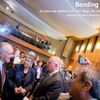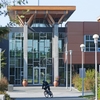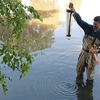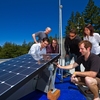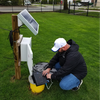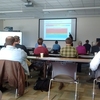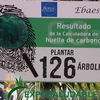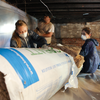Air & Climate
Introduction
Global climate change is having myriad negative impacts throughout the world, including increased frequency and potency of extreme weather events, sea level rise, species extinction, water shortages, declining agricultural production, and spread of diseases. The impacts are particularly pronounced for low-income communities and countries. In addition, institutions that inventory and take steps to reduce their air pollutant emissions can positively impact the health of the campus community, as well as the health of their local communities and regions.
Featured Resources
Latest News from AASHE Bulletin
New Resources
Can carbon offsets be community-based, educational, and affordable? The results of a 4 college collaborative research project.
- Amherst College (MA)
- Hampshire College (MA)
- Smith College (MA)
- Williams College (MA)
What would be the best carbon offset? Can carbon offsets achieve measurable carbon reductions, as well as support the health and sustainability of our local communities and provide educational and …
- Posted Nov. 18, 2016
- Conference Presentations
- View more
Obama, Bill Gates to lead major effort to spur spending on climate research
- The Washington Post (DC)
This article describes the launch of two separate initiatives to invest billions of dollars in clean energy research and development. "Mission Innovation” is a commitment by countries - including United …
- Posted Nov. 14, 2016
- Publications
- View more
Harvard to limit greenhouse gas emissions in new Allston construction
- Harvard University (MA)
This article describes Harvard University's agreement to limit greenhouse gas emissions from new buildings constructed on its Allston campus. The agreement between the University and the Executive Office of Energy …
- Posted Nov. 1, 2016
- Publications
- View more
Master of Climate Change
- University of Waterloo (ON)
The University of Waterloo’s Master of Climate Change (MCC) program focuses on the multiple ways climate change interacts with society and the environment. The MCC program provides a unique educational …
- Posted Oct. 31, 2016
- Academic Programs
- View more
Making the invisible visible: how students make use of carbon footprint calculator in environmental education
- University of Gothenburg
Problems concerning carbon dioxide emissions and other climate change-related issues are on the global political agenda and constantly debated in media. Such issues are important for individuals to enable active …
- Posted Oct. 28, 2016
- Publications
- View more
A Nearly Carbon-Neutral Conference Model: White Paper & Practical Guide
- University of California, Santa Barbara (CA)
This document was created to help stage nearly carbon-neutral (NCN) conferences based on a model first implemented at UC Santa Barbara (UCSB) in May of 2016. Compared to fly-in conferences, …
- Posted Oct. 28, 2016
- Publications
- View more
Report: Options for Achieving a Carbon Neutral Campus by 2035
- Cornell University (NY)
Created by the Senior Leaders Climate Action Group at Cornell University to better inform decision-making on reaching carbon neutrality by 2035. The report focuses on cost-benefit analysis of solutions to …
- Posted Oct. 21, 2016
- Publications
- View more
Teaching Climate Change in the Humanities
Climate change is an enormous and increasingly urgent issue. This important book highlights how humanities disciplines can mobilize the creative and critical power of students, teachers, and communities to confront …
- Posted Oct. 20, 2016
- Publications
- View more
Sustainability Photos from Colorado State University
- Colorado State University (CO)
- Posted Sept. 23, 2016
- Photographs
- View more
Climate & Energy Strategy
- University of California, Santa Cruz (CA)
UC Santa Cruz convenes staff, students and faculty to discuss how to meet the UC systemwide goal of achieving carbon neutrality by 2025 and next steps for implementation of the …
- Posted Sept. 14, 2016
- Photographs
- View more
UVic Administrative Services Building LEED Gold
- University of Victoria (BC)
University of Victoria's Administrative Services Building LEED Gold
- Posted Sept. 14, 2016
- Photographs
- View more
UConn Reserach Gathers Critical Information Needed in Fight to Save Wildlife
- University of Connecticut (CT)
An international group of top biologists led by UConn ecologist Mark Urban is calling for a coordinated effort to gather important species information that is urgently needed to improve predictions …
- Posted Sept. 14, 2016
- Photographs
- View more
Summer 2016 - St. John's University upgraded 41,000 lamps and 6,000 fixtures to LED
- St. John's University, New York (NY)
In Summer 2016, St. John's University invested $1.4 million to upgrade 41,000 lamps and 6,000 light fixtures to LED technology. Highlights of the project include:
- Utility company will share up …
- Posted Sept. 12, 2016
- Photographs
- View more
Columbia University Bike-Share Program
- Columbia University (NY)
- Zagster (MA)
Columbia recognizes the many benefits of bicycle travel and is continuing its efforts towards growing bike culture as part of the University’s commitment to a healthy and sustainable Columbia. Creating …
- Posted Sept. 12, 2016
- Photographs
- View more
UBC Sustainability - University Boulevard
- The University of British Columbia (BC)
Using our campus as a living lab model, we are treating our campus as one interconnected system. We are continuously implementing strategies to effectively manage campus energy, water, waste, food …
- Posted Sept. 12, 2016
- Photographs
- View more
UBC Sustainability - CIRS Building
- The University of British Columbia (BC)
CIRS was conceived as a building in which to push the envelope of sustainable design by integrating passive design strategies with innovative sustainable technologies.
- Posted Sept. 12, 2016
- Photographs
- View more
Renewable Energy Projects at UC Santa Cruz
- University of California, Santa Cruz (CA)
At the University of California, Santa Cruz, a cross-disciplinary group of engineering undergraduates--the "Green Wharf Renewable Energy Project" team--shows off its senior capstone design project, a low-impact marine microgrid energy …
- Posted Sept. 12, 2016
- Photographs
- View more
Ball State University Campus-Wide Clean Energy Efficiency Geothermal Project
- Ball State University (IN)
The system implementation demonstrates that geothermal energy coupled with ground source heat pump technology can be used on a large-scale district distribution system.
- Posted Sept. 9, 2016
- Photographs
- View more
Business Instructional Facility Solar Array at University of Illinois at Urbana-Champaign
- University of Illinois, Urbana-Champaign (IL)
- Posted Sept. 8, 2016
- Photographs
- View more
UOIT Borehole Thermal Energy Storage System
- Ontario Tech University (ON)
Located underneath the Campus Polonsky Commons shown here is the second largest geothermal well system in North America. The system serves all north campus buildings and is made up of …
- Posted Sept. 6, 2016
- Photographs
- View more
Certificate in Greenhouse Gas Management
- George Washington University (DC)
- Greenhouse Gas Management Institute (MD)
The Certificate in Greenhouse Gas Management is designed to prepare students professionally to contribute to the coming low carbon future. The George Washington University partnered with the Greenhouse Gas Management …
- Posted Aug. 24, 2016
- Academic Programs
- View more
Master of Science in Energy Systems Management
- University of San Francisco (CA)
The Master of Science in Energy Systems Management is designed for people seeking the skills and knowledge to work in the fast changing world of electrical generation, distribution, conservation, and …
- Posted Aug. 12, 2016
- Academic Programs
- View more
The health effects of climate change: What does a nurse need to know?
- University of Plymouth (Devon)
The scientific evidence for anthropogenic climate change has been established with increasing precision and there are widespread concerns about its potential to undermine the public health gains of the past …
- Posted Aug. 1, 2016
- Publications
- View more
Guidelines for College-Level Greenhouse Gas Emissions Inventories
- Lewis & Clark College (OR)
- National Wildlife Federation (VA)
- Second Nature (MA)
This guide is the product of a summer research project performing a GHG emissions inventory for Lewis & Clark College and a full school year refining the method. It includes …
- Posted Aug. 1, 2016
- Publications
- View more
Achieving Carbon Neutrality at UCSB by 2025: A Critical Analysis of Technological and Financial Strategies
- University of California, Santa Barbara (CA)
In 2013, University of California (UC) President Janet Napolitano established the Carbon Neutrality Initiative (CNI), a commitment to eliminate all Scope 1 and Scope 2 emissions by 2025. As one …
- Posted July 28, 2016
- Publications
- View more
Co-designing research on transgressive learning in times of climate change
- Wageningen University
This paper reflects on the epistemological context for the co-design of a research programme on transformative, transgressive learning emerging at the nexus of climate change, water and food security, energy …
- Posted July 21, 2016
- Publications
- View more
Boldly Sustainable: Hope & Opportunity for Higher Education in the age of Climate Change
- National Association of College & University Business Officers (NACUBO) (DC)
Sustainability is a powerful strategy for higher education to achieve renewal, reformation, and relevance in the 21st century. Boldly Sustainable examines how colleges and universities can leverage their commitment to …
- Posted July 21, 2016
- Publications
- View more
Pre-Service Teachers and Climate Change: A Stalemate?
- James Cook University (Queensland)
Findings from the second phase of a study of pre-service teachers’ attitudes to environmental education and knowledge of climate change are reported in this paper. A sample of 87 pre-service …
- Posted June 20, 2016
- Publications
- View more
Center for Climate Change Impacts and Adaptation
- University of California San Diego (CA)
Climate change is in motion. If societies do not respond, their populations face water and food shortages and severe economic disruptions. Countless plant and animal species will be at risk. …
- Posted June 20, 2016
- Research Centers & Institutes
- View more
Master of Advanced Studies in Climate Science and Policy
- University of California San Diego (CA)
The master of advanced studies (MAS) in Climate Science and Policy is a unique program of study providing advanced training in climate science and policy for working professionals in government, …
- Posted June 20, 2016
- Academic Programs
- View more
Atlanta People's Climate March and Climate Summits
- Georgia State University (GA)
Sustainable Energy Tribe (SET), the largest student environmental group on Georgia State University's campus, worked to make climate change and environmental justice major themes for the year. These efforts had …
- Posted June 16, 2016
- Case Studies
- View more
UCSC Climate & Energy Strategy- A Roadmap to Carbon Neutrality by 2025
- University of California, Santa Cruz (CA)
Over the past 18 months, UCSC has been implementing a process to develop a comprehensive Climate and Energy Strategy (CES) to support its goal of reaching carbon neutrality by 2025. …
- Posted June 11, 2016
- Case Studies
- View more
Middlebury College's Innovative Land Conservation and Financing Project
- Middlebury College (VT)
In 1915, a visionary Vermont environmentalist bequeathed to Middlebury College a large tract of land, located 12 miles from the main campus, part of which became home to the College’s …
- Posted June 11, 2016
- Case Studies
- View more
Carbon Neutrality at Université Laval
- Université Laval (QC)
As the first voluntarily carbon neutral university in Canada, Université Laval (UL) made sure its process was transparent so that any organization looking to combat climate change could refer to …
- Posted June 10, 2016
- Case Studies
- View more
The Morris Model: Catalyzing Community Resilience, Energy Conservation and Clean Energy Planning and Action
- University of Minnesota, Morris (MN)
The University of Minnesota, Morris (UMM) has demonstrated a successful planning approach with partners across the state to build climate resilience into the consciousness and planning efforts of the city …
- Posted June 10, 2016
- Case Studies
- View more
Carbon management at universities: a reality check
- University of Southampton
Carbon dioxide emissions from the higher education sector are globally significant. This study compares the performance of 20 institutions in English research-intensive universities to their self-set targets, using three key …
- Posted June 10, 2016
- Publications
- View more
Carbon footprint analysis of student behavior for a sustainable university campus in China
- Drexel University (PA)
Sustainable urban design, systems-level organizational planning, and human behavior have all been recognized for their potentially important roles in helping to reduce energy costs and associated environmental impacts, including greenhouse …
- Posted June 10, 2016
- Publications
- View more
Doubling Energy Efficiency at the University of Michigan by 2030
- University of Michigan (MI)
- Johnson Controls, Inc (WI)
Approximately 84 million Americans spend their days in colleges, universities, and public or private primary and secondary schools. The commercial building sector, which includes educational institutions, accounts for 18.44 percent …
- Posted June 8, 2016
- Publications
- View more
Development of a Carbon Capital Methodology for use by the Higher Education Community
- Ball State University (IN)
Over a multiyear period, Ball State University collaborated in the development and piloted the implementation of a new methodology by which colleges and universities can qualify their carbon reduction credits …
- Posted June 6, 2016
- Case Studies
- View more
Carbon Neutral ExpoSaludable Fair Event in Bolivia
- Berea College (KY)
We calculated the carbon emissions released during the ExpoSaludable fair in Bolivia to offset our footprint by planting trees in Santa Cruz, the city where the event takes place. The …
- Posted June 6, 2016
- Case Studies
- View more
Sustainable Fleet at Yale University
- Yale University (CT)
At Yale University, transportation is vital to the University's operation. Fleet Management is a department that has gone to tremendous lengths to provide exceptional transit services for the entire university. …
- Posted June 6, 2016
- Case Studies
- View more
UC Cool Campus Challenge
- University of California, Office of the President (CA)
In the fall of 2015, the Cool Campus Challenge (CCC) engaged nearly 20,000 staff, students and faculty at the University of California (UC) in an online pledge campaign aimed at …
- Posted June 6, 2016
- Case Studies
- View more
Stanford Carbon Offsets to Reduce Emissions (SCORE)
- Stanford University (CA)
The Stanford Athletic Department boasts 36 varsity sports teams and over 900 student-athletes. These teams travel all over the country to compete at the highest levels of collegiate competition, but …
- Posted June 6, 2016
- Case Studies
- View more
The Urgent Need for Universities to Comprehensively Address Global Climate Change Across Disciplines and Programs
- Minot State University (ND)
I review the status of scientific, political, and moral problems of global climate change (GCC) and, based on lessons from environmental and sustainability programs in universities, demonstrate that universities have …
- Posted June 3, 2016
- Publications
- View more
Report on the Study Group on Climate Change Participatory Workshop
- Smith College (MA)
New England’s climate is projected to experience signifiant changes in the near future, including warmer temperatures, varied precipitation and extended periods of drought, with more extreme rainfall and snowfall events. …
- Posted June 1, 2016
- Publications
- View more
Compact Advanced Facility for Conversion of Waste Cooking Oil to Biodiesel to power the University Bus system
- University of South Florida (Tampa) (FL)
The University Bus system is powered by a Biodiesel mixture. The project investigated feasibility of generating its own Biodiesel from the waste cooking oil generated by the dining facilities and …
- Posted May 26, 2016
- Case Studies
- View more
Carbon On-Setting: Community Impact through Home Weatherization in Greenville, SC
- Furman University (SC)
The Community Conservation Corps (CCC), a program of the David E. Shi Center for Sustainability at Furman University, provides free home weatherization to low-income homeowners in the greater Greenville, South …
- Posted May 20, 2016
- Case Studies
- View more
Prairie Climate Atlas
- University of Winnipeg (MB)
The new Prairie Climate Atlas is an interactive, online tool that uses climate data, geovisualizations and multimedia to map the dramatic changes predicted for the Canadian Prairies. The Atlas is …
- Posted May 17, 2016
- Tools
- View more
The methodology and results of using life cycle assessment to measure and reduce the greenhouse gas emissions footprint of Major Events at the University of Arizona
- Michigan Technological University (MI)
- University of Arizona (AZ)
In 2012 and 2013, the University of Arizona’s Office of Sustainability conducted environmental life cycle assessments of two Homecoming events that drew 60,000 attendees each. Based on reviews of published …
- Posted May 17, 2016
- Publications
- View more
Going Geothermal: The Project Dedication Video
- Ball State University (IN)
True to our tradition of innovation, Ball State continues to be revolutionary and responsible. We are creating the nation's largest ground-source, closed-loop district geothermal energy system, benefiting both the economy …
- Posted May 13, 2016
- Videos & Webinars
- View more
This tab provides access to data collected through AASHE’s Sustainability Tracking, Assessment & Rating System™ (STARS). STARS is a transparent, self-reporting framework for colleges and universities to measure their sustainability performance. STARS enables meaningful comparisons over time and across institutions using a common set of measurements developed with broad participation from the campus sustainability community.
All responses reference content from reports under the latest version of STARS, version 2.2. AASHE membership and log-in is required.
OP 1: Emissions Inventory & Disclosure
- Description of the methodology and/or tool used to complete the GHG emissions inventory
- GHG emissions inventory (upload)
- Brief description of the GHG inventory verification process
- Brief description of the methodology for completing an air emissions inventory
OP 2: Greenhouse Gas Emissions
- Adjusted net Scope 1 and 2 GHG emissions per weighted campus user, performance year
- Adjusted net Scope 1 and 2 GHG emissions per unit of EUI-adjusted floor area, performance year
- A brief description of the institution’s GHG emissions reduction initiatives
- Website URL where information about the institution's GHG emissions is available
Additional analysis on scores and quantitative fields can be conducted using the STARS Benchmarking Tool.


